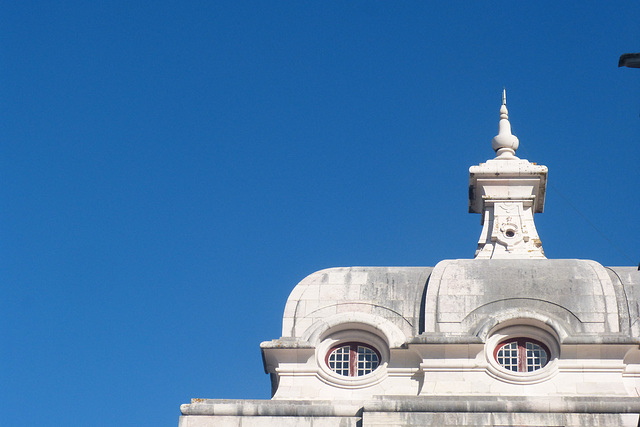The new light.
Mafra - The Church
Palace of Mafra - Library
Man Made
Centuries
Santarém - II
Gothic
Simple chalet staircase - Finland
Idea
Expo 98 - Pavillion of Portugal - 50 x 60 meters a…
Sunrise in Town
Man made
HFF
Sunrise
Gare do Oriente IV
Gare do Oriente - II
Brave New World
HFF
Gare do Oriente - I
HFF
Steel
Lines
Man Made
Age old water mill
Agro Museum
Morning shift
Myosotis
300 tones max, how to . . .
Norway - speed: 8 km/h maxi
Wood and Iron
HFF
The old way...
Nenúfar
HFF
Poppies to this Day
To a friend - Ceramicas
Painel
Manuel Cargaleiro
Cargaleiro - My neighbour's door
Cargaleiro III
Cargaleiro IV
Cargaleiro VII
I am back.
Vila Viçosa - Paço Ducal
Flowers, only.
See also...
Keywords
Authorizations, license
-
Visible by: Everyone -
All rights reserved
-
603 visits
MAFRA - The Carillons


The Carillons
The Royal Convent of Mafra has a set of two carillons, or rather a series of bells tuned to each other. There are actually ninety eight bells in all, which makes them the world’s largest historic carillons.
The story goes that the Marquis of Abrantes, upon the King’s request, was informed that one carillon would cost him 400.000$00 réis – an astronomic price for a country as small as Portugal. Offended with such remark, King João V is said to have answered: “Well if it is that cheap, I’ll have two”.
The bells of the North tower carillon were wrought in Liège by Nicolau Levache, while those of the South tower were made in Antwerp by Willem Witlockx.
Each bell tower had fifty eight bells, forty nine in each belonging to the carillon.
The heaviest bells weigh 725 arrobas each [1 arroba = 14,688 kg], i.e., around 9.180 kg. The second heaviest bells weigh 291 arrobas each, i.e., 4.270 kg; the third category bells weigh 231 arrobas, i.e., around 3.392 kg, and the fourth range bells 99 arrobas, or around 1.454 kg. Their size goes on decreasing with some weighing 1 arroba, and the smallest of all around 15 kg.
Finally the carillons wheels and other devices weigh 1.420 quintais [1 quintal = 58,752 kg], i.e., 83.427,84 kg.
Besides the carillon, there are eleven liturgical bells of Portuguese and Italian foundry, dating from 1730 to the late 19th century, an unique illustration of the liturgical use of bells.
The religious community attached such importance to the bells that they had up to 24 lay brothers working on them under the coordination of a lay friar. They had independent accommodations near the towers, including cells, one refectory and a chapel for spiritual exercises. Wikipedia
The Royal Convent of Mafra has a set of two carillons, or rather a series of bells tuned to each other. There are actually ninety eight bells in all, which makes them the world’s largest historic carillons.
The story goes that the Marquis of Abrantes, upon the King’s request, was informed that one carillon would cost him 400.000$00 réis – an astronomic price for a country as small as Portugal. Offended with such remark, King João V is said to have answered: “Well if it is that cheap, I’ll have two”.
The bells of the North tower carillon were wrought in Liège by Nicolau Levache, while those of the South tower were made in Antwerp by Willem Witlockx.
Each bell tower had fifty eight bells, forty nine in each belonging to the carillon.
The heaviest bells weigh 725 arrobas each [1 arroba = 14,688 kg], i.e., around 9.180 kg. The second heaviest bells weigh 291 arrobas each, i.e., 4.270 kg; the third category bells weigh 231 arrobas, i.e., around 3.392 kg, and the fourth range bells 99 arrobas, or around 1.454 kg. Their size goes on decreasing with some weighing 1 arroba, and the smallest of all around 15 kg.
Finally the carillons wheels and other devices weigh 1.420 quintais [1 quintal = 58,752 kg], i.e., 83.427,84 kg.
Besides the carillon, there are eleven liturgical bells of Portuguese and Italian foundry, dating from 1730 to the late 19th century, an unique illustration of the liturgical use of bells.
The religious community attached such importance to the bells that they had up to 24 lay brothers working on them under the coordination of a lay friar. They had independent accommodations near the towers, including cells, one refectory and a chapel for spiritual exercises. Wikipedia
Anne H, Dimas Sequeira, , Trudy Tuinstra and 14 other people have particularly liked this photo
- Keyboard shortcuts:
Jump to top
RSS feed- Latest comments - Subscribe to the comment feeds of this photo
- ipernity © 2007-2024
- Help & Contact
|
Club news
|
About ipernity
|
History |
ipernity Club & Prices |
Guide of good conduct
Donate | Group guidelines | Privacy policy | Terms of use | Statutes | In memoria -
Facebook
Twitter

Admired in:
www.ipernity.com/group/tolerance
It's all in your hands...
www.ipernity.com/group/2324220
Historical & Architectural Gems
Sign-in to write a comment.